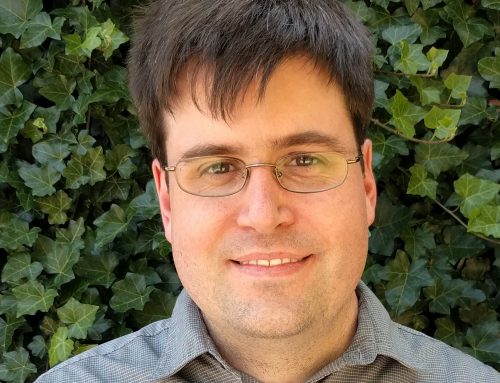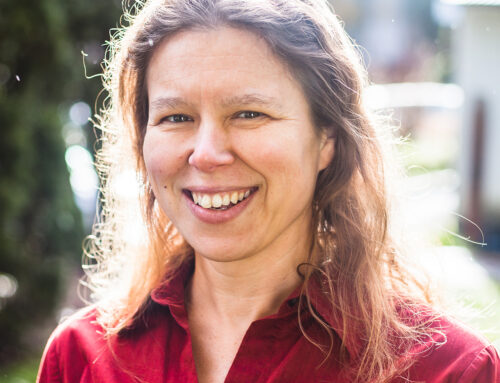Kasey was a project manager in wireless communications before coming to Gutenberg College at age thirty-two. She graduated in June 2009 and worked as Gutenberg’s recruiter and director of Admissions for a year after graduation.
* * *
When potential students come to visit Gutenberg, my job is to describe the curriculum and what they can expect from the next four years. This has become a significant challenge: describing a great-books curriculum is one thing; describing the four-year project that students undertake when studying at Gutenberg is quite another.
Instead of taking prospective students through the reading list or explaining the class schedule, I describe my own experience as a Gutenberg student. I tried another college before I came to Gutenberg. Working through the curriculum there was similar to buying a condo: I could pick out the carpet and the wall color, but the structure was already built, ready to go. And I discovered that it wasn’t my job to inspect “the building” or to question it; rather, I was simply supposed to move in and get used to dwelling there. Further, the goal of the curriculum was not to lead me down a path toward becoming a critical thinker or a life-long student, but rather the goal was to “train me” in a vocation.
As a young student, it became clear to me that most pre-packaged curriculums are predigested systems of belief. They are easy to accept and easy to get used to—you just have to learn the system. Or at least you have to be able to take a test on it. Passively receiving a worldview, however, is like moving into someone else’s hard work. Further, one is also likely to passively receive the furnishings that inevitably creep inside. Culture makes a profound interior decorator: the next thing you know, you are eating off a set of an assumed ethic, sitting in a lazy conception of truth, and dressing only in the immediate.
The contrast: at Gutenberg, there are no hand-me-downs. And instead of buying, students build. The groundwork—not the building—starts at orientation. Before I could build, I was issued a wrecking ball, explosives, and large, heavy equipment to mow down—or at least make me contemplate—where I had been dwelling. And then somewhere along the way, I was handed a hammer and a can of nails and told to “start building.” For me, Gutenberg was four years of raw, messy, and hard work.
There were moments when I wondered if the very foundation upon which I was standing was going to cave in and leave me buried in a heap of rubble. But it was at those moments that the curriculum was the most profound.
I listened to Socrates urging me to “let no day pass without discussing goodness” because “it really is the very best thing that a man can do” and “life without this sort of examination is not worth living.” Then Kierkegaard warned me against the security and safety of a cozy set of doctrines; he pushed the question of immortality beyond a doctrinal checklist. And lastly, Jesus the Messiah asked, “What does it profit a man to gain a fortune and lose his soul?”
At Gutenberg, students do not receive a prepackaged worldview. Instead they learn how to become life-long students. They do not invest in a training program. Rather, they invest in something different: a permanent “Under Construction” sign—that is, a commitment to continue seeking and to care about goodness, truth, and the well-lived life.
I began recruiting for Gutenberg College just over one year ago. Since then, a handful of projects have been completed, including two recently: whygutenberg.com and a Gutenberg iTunes University (iTunes U) site.
whygutenberg.com is a microsite, an internet tool similar to a website, that is designed to convey Gutenberg’s ethos more than to provide large quantities of information. We want people to get a feel for Gutenberg and then pursue more information on gutenberg.edu. The whygutenberg.com site is the result of the creative talents of many volunteer students, alumni, and friends in the Gutenberg community.
iTunes U is part of Apple Inc.’s iTunes (where people can download music and podcasts) that is designed for academic institutions to be able to make available podcasts, PDFs, and videos to the public. Apple allows colleges and universities to use iTunes U free of charge. You can still download audio files from Gutenberg’s McKenzie Study Center institute (mckenziestudycenter.org). At Gutenberg’s iTunes U site, you can download both audio and video files, and the site provides easier download access for people with iPods.
Both whygutenberg.com and iTunes U will help me in my job to recruit new students to Gutenberg College. But you can help, too, by getting the word out about Gutenberg. Please visit whygutenberg.com, and forward a link to people who may be interested in Gutenberg College. Please tell people about Gutenberg’s iTunes U site. (They can get there by going to the front page of Gutenberg College’s website—www.gutenberg.edu—and clicking on “Visit Gutenberg at iTunes U.”) Please consider hosting a house party to discuss Gutenberg College or hosting an event for one of the tutors to speak. Gutenberg College has changed my life, and I want other people to know about the unique educational opportunity Gutenberg provides.






